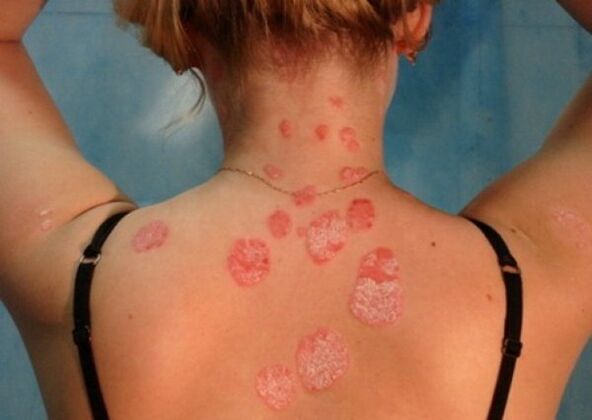
Psoriasis (also known as lichen scales) is a non-communicable chronic and often recurrent skin disease.
Psoriasis, the symptoms of which determine the tendency to damage the periarticular tissues, manifests itself in the form of scaly papules, in addition, it should be noted that this disease is one of the most common skin lesions that occur at any age.
The etiology of this disease has not yet been fully studied and proven, but many dermatologists still agree that psoriasis is a disease directly related to genetic inherited pathologies.
Do not self-medicate. At the first sign of illness, consult a doctor.
general description
Psoriasis is characterized by the duration and duration of its course. His remissions, which may last several months or years, indicate that he will return later and continue for the rest of his life. Spontaneous treatment of this disease is very rare.
If you try to identify a certain category of people who are prone to the onset of psoriasis, the solution will not be unambiguous. The fact is that psoriasis, which acts as a systemic process, develops not only in people with actual immune disorders, but also in people with certain functional or morphological disorders associated with the functions of various systems and organs.
Psoriasis, which belongs to the group of dermatoses, is one of the most studied diseases in them. Meanwhile, none of the hypotheses available today can fully determine the nature of this disease. Given this, the problems associated with its therapy and prevention are still uncertain and acute. Depending on the specific time, there are different opinions about the origin of psoriasis. This, in turn, led to the selection of a number of forms, each based on the results of certain laboratory studies and clinical observations.
- The hereditary nature of the disease. This implies the presence of psoriasis in a review of several generations in which cases of the disease have been reported, respectively. By the way, heredity is considered to be the main and reliable cause of the development of psoriasis (in this case, psoriasis grows under the influence of various stimuli).
- The metabolic nature of the disease. In this case, disorders of fat metabolism (ie, cholesterol metabolism), a decrease in morbidity during starvation, an increase in the amount of phosphorus in psoriatic scales, etc.
- The viral nature of the disease. In this case, the concept of direct involvement of viral infection in the etiology of the disease under consideration, based on numerous and long-term clinical observations, has been formed. Accordingly, for the same reason, the infectious (and also viral) nature of psoriasis as a theory is the oldest. Thus, the end of the 19th century was marked by the formation of very large groups of psoriatic type, formed against the background of patients suffering from diseases such as scarlet fever and influenza. The systemic nature of the actual lesion, its recurrent and long-lasting course, its association with meteorological and heliophysical factors, as well as some features characteristic of the evolution of the rash characteristic of psoriasis, also confirmed the infectious nature. disease. Currently, the search is on for viral agents that can trigger the psoriatic process.
- The endocrine nature of the disease. In the recent past, the theory of a direct link between the onset of psoriasis and the endocrine (as well as metabolic) nature has been supported by many. When examining patients with psoriasis, certain disorders of the endocrine scale were very often found, which justified the urgency of such a relationship. In particular, the disorders of the functional state of the gonads, the effects of menstruation, pregnancy, childbirth and lactation, the obvious type of changes found during the study of the pituitary-adrenal system of patients were highlighted.
- The neurogenic nature of the disease. What is relevant to the patient (or rather, after the transplant) is the onset of the disease against the background of nerve shock. In about 30% of cases, the exacerbation of the disease occurs on the basis of stress. In this case, patients' ability to withstand the effects of stress and the subsequent transfer of results is reduced. At the same time, their disorders (asthenic, vegetative-vascular-visceral, vegetative-vascular-dystonic and asthenodepressive) together with neurotic reactions lead to the formation of predominant vicious circle or even exacerbate it.
Classification
As already mentioned, psoriasis is a chronic and recurrent disease. Any of its existing forms can be attributed to one of the appropriate classification options for psoriasis, where there is a distribution for pustular or non-pustular psoriasis. In general, the classification is as follows:
- Pustular psoriasis
- generalized psoriasis;
- anular psoriasis (anular pustulosis);
- palmoplantar psoriasis (psoriasis of the extremities, persistent palmoplantar pustulosis, barbera pustular psoriasis);
- chronic form of persistent acrodermatitis (psoriasis of the soles and palms, palmar-plantar psoriasis);
- herpetiform psoriatic impetigo.
- Non-pustular psoriasis
- psoriasis vulgaris or psoriasis vulgaris, simple psoriasis (plaque, persistent psoriasis in chronic form);
- psoriatic erythroderma (erythrodermic psoriasis).
A number of authors consider it necessary to add this classification, so the types or forms of psoriasis can be added to it in the following variants:
- seborrheic-like psoriasis (seborrheic psoriasis);
- napkin psoriasis;
- drug-induced psoriasis;
- "Reversible psoriasis" (psoriasis of the skin folds, curved surfaces).
Psoriasis: symptoms
The first sign of psoriasis is a rash of billion-type papules, characterized by a gradual increase along the periphery, which also turns them into nummular and lenticular papules and merges with each other, so plaques of different sizes appear. The development of psoriasis within the skin determines three main stages for it.
The first stage
This stage is defined as a progressive stage, which is associated with the formation of new formations (actually papules) on the skin, as well as an increase in the size of existing formations in the skin. It is also accompanied by the formation of an erythematous border around the lesions (such a border is defined as a peripheral growth zone). Plaque along the edges is not susceptible to peeling, peeling acts as the last stage of inflammation and does not keep pace with the process of growth of psoriatic formations.
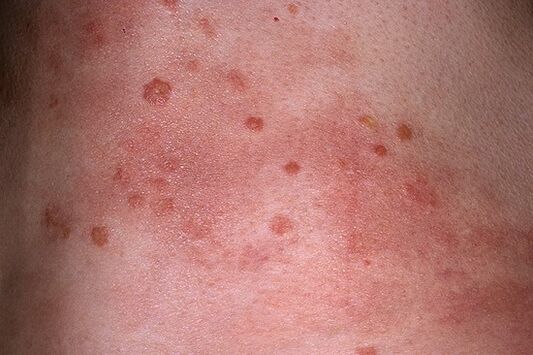
The second stage
The second stage defines a stationary period in which new elements are not visible, but existing elements in the form of plaques and papules do not change in size. In general, the appearance of papules can be completed at any stage, so the stationary period may be accompanied by the simultaneous appearance of billion papules, lenticular and numular papules. Let's explain what these three types of papules are. Thus, nummular papules are elements of a rounded skin rash with a diameter of 15-20 mm (hence these papules are also called coin-shaped). Lenticular papules, in turn, are lentil-like, straight or convex, oval or round in shape. Finally, billions of papules that have the conical shape of the elements and thus resemble hemp seeds. Basically, these papules are small, the predominant area is near the hair follicles.
The third stage
This stage is reversed (or regressive). Its main feature is that the rash gradually disappears and a pseudosclerotic-type whitish border (defined as the Voronov ring) forms around the foci. During this period, some patients may have mild itching. As for any subjective feelings, they are mostly insignificant and do not exist at all.
The appearance of rashes can be noted in any area of the skin, but they are mainly localized on the surface of the curvature of the extremities, especially in the elbow and knee joints, in the sacral region. scalp (here, especially the area along the edge of the hair growth designated as the "Psoriatic crown" is different). Although psoriasis on the scalp is characterized by the severity of its symptoms, it does not cause changes in the structure of the hair, as well as their loss.
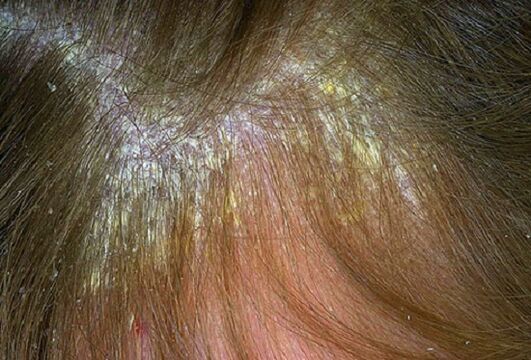
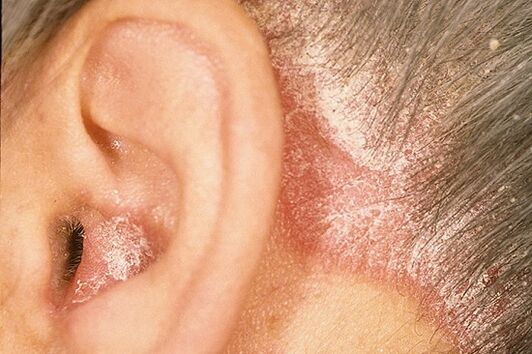
As for the concentration of plaques within the extensor surface of the knee and elbow joints, here they often last longer than the rash is generally removed (this feature defines them as "duty" plaques). Some patients are faced with the fact that the skin folds in the groin-femoral region or mammary glands, as well as the axillary glands are affected, and often such a lesion can be isolated.
Irritated psoriasis
It develops against the background of active exposure to the skin with progressive psoriasis, which already exists, of certain irritants, especially sunlight or special ointments, as well as other types of irritants that affect the plaques. These plaques, in turn, become more convex, change color to cherry red, forming a hyperthermic zone around them, as a result of which the sharp borders become slightly blurred. After the solution of the board, this belt takes on a wrinkled appearance.
Spotted psoriasis
This form of the disease manifests itself in the form of slight infiltration of the rash elements (in the general definition, infiltration is the impregnation of tissues with this or that substance). They, in turn, look like spots (not papules). Spotted psoriasis, as a rule, develops sharply and is also characterized by similarity to toxidermia. The main method in the differentiation of the disease is to determine the compatibility of the course of the disease with the characteristic psoriatic triad.
Old psoriasis
This form of the disease can be considered in terms of symptoms in the form of severe infiltration of the plates with a hyperkeratotic or warty surface, their general cyanosis. These types of foci are particularly difficult to treat, and it is possible that they may develop into malignant tumors in the future (this is rare, but unfortunately this option should not be ruled out).
Seborrheic psoriasis
This form of psoriasis, as the name implies, develops in patients with seborrhea, which already belongs to them. The disease manifests itself in the scalp, behind the ears, in the chest, in the area of the nasolabial folds, in the lower back and lower back. The resulting psoriatic scales are intensively saturated with sebum, so they stick together and remain inside the plaque surfaces, allowing the disease to simulate a scene characteristic of seborrheic eczema.
Palmar-plantar psoriasis
The disease can manifest itself either in the form of ordinary psoriatic plaques and papules, or in the form of hyperkeratotic compounds that simulate calluses and calluses. In some cases, psoriasis is persistent in the hands, the symptoms of which are marked on the palms (or on the feet - by definition, on the heel), which manifests itself in the form of increased thickening or keratinization. . The boundaries of this type of lesion are characterized by clarity, more rarely this form of psoriasis is limited to the appearance of a large ring of peeling.
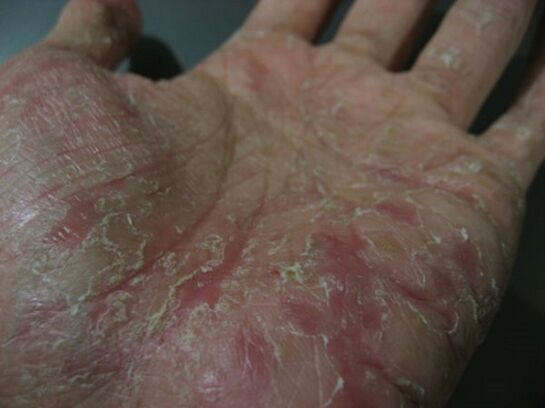
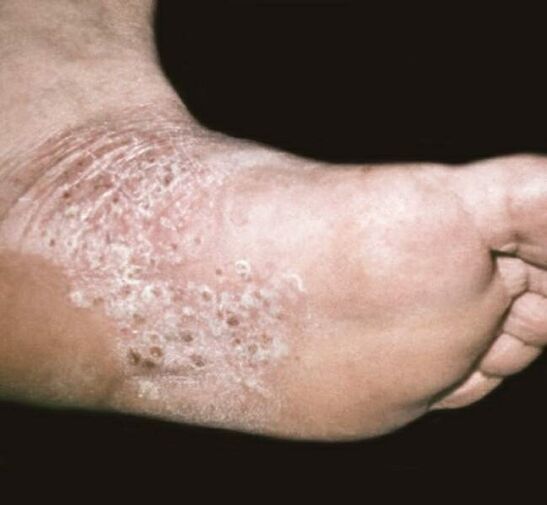
Exudative psoriasis
This form of psoriasis is characterized by excessive exudate during the inflammatory reaction, manifesting itself in the advanced stages of the course of psoriasis. The exudate on the surface of the papule saturates the accumulation of scales, thus forming crust-like formations. These elements are secondary, they are defined as flakes, the color of these elements is yellowish. After removing them, they are exposed to a little bleeding and weeping surface. Dried and layered scale scales often form a massive conglomerate resembling an oyster shell (already defined as rupioid psoriasis).
Guttate psoriasis
Sudden onset of symptoms of psoriasis is characterized by the formation of numerous spots on the skin. The disease is mainly diagnosed in patients aged 8 to 16 years. Streptococcal infection often acts as a precursor to tearful psoriasis.
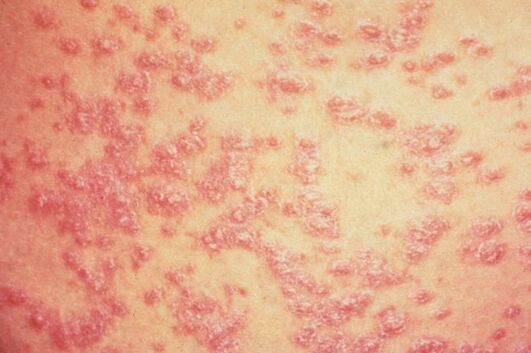
Psoriasis of the nails
Depending on the degree of damage to the nails, psoriasis of the nails, which provides isolation of this type of psoriasis in three main forms, can be atrophic, spotted or hypertrophic.
The formation of punctate depressions on the nail plates is considered a point lesion, which can be compared with a raised surface. Manifestations of this form of psoriasis are possible in a slightly different version, which is similar in specificity to onychomycosis. In this case, inside the free edge, the nail plate changes color, becomes dull, and tends to collapse without much effort. An inflammatory border formed along the periphery of the affected nail plate area is identified as a sign that allows psoriasis to be differentiated. Presented as the edge of the papule inside the nail bed visible from the nail plate.
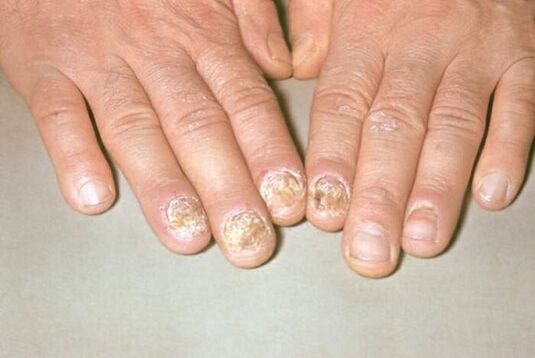
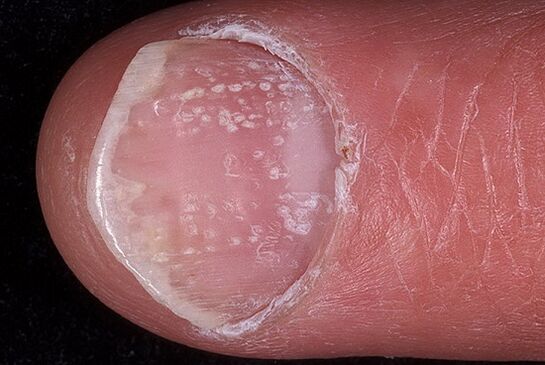
Psoriatic (psoriasis) arthritis
Psoriatic arthritis, characterized by infiltration of periarticular tissues with simultaneous damage to the joints, mainly affects the interphalangeal joints. Meanwhile, the possibility of involvement of large joints in the pathological process is not ruled out, the joints and articulations of the sacroiliac spine are very rarely at risk in this regard.
It should be noted that psoriatic arthritis, unlike other types of arthritis (generally defined as inflammation of the joints), occurs in the background of psoriatic rash, which is already present in the patient and is often associated with nail damage. . In addition, it is important to note that the onset of this type of arthritis is associated with exacerbation of psoriasis within the skin and is often exudative.
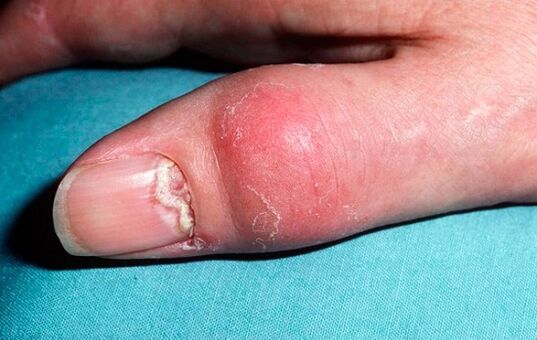
During the progression of the disease, irrational treatment is often accompanied by a non-specific reaction from the body. It is toxic-allergic in nature and consists of the appearance of redness in areas not affected by psoriatic plaques, this redness, combined, completely affects the skin. This process is accompanied by high temperature (in a range not exceeding 39 degrees), as well as an increase in lymph nodes, a feeling of tightness of the skin, its burning and itching. In many cases, there is also excessive peeling, thickening and abrasion of the nail plates, hair loss. This picture already shows the relevance of psoriatic erythroderma. Erythroderma ends with the restoration of the traditional version of the course of psoriasis.
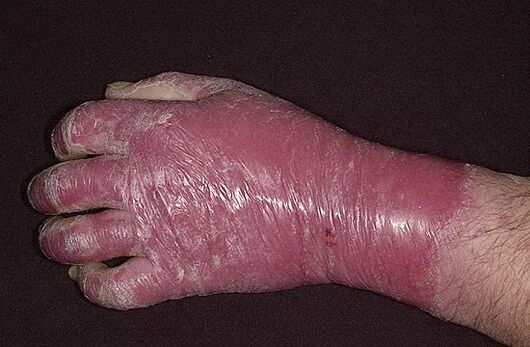
In general, recurrence of the disease occurs in the autumn-winter, as well as spring-summer periods, which is an important factor to consider, including when prescribing the necessary treatment.
Treatment of psoriasis
Before prescribing treatment, the patient is thoroughly examined, and in order to determine the specific measures, they are required to determine the stage of the disease, clinical diversity, general condition of the patient, the presence of concomitant diseases, seasonality of disease manifestations, etc. About the fastest and at the same time, with a short course, a favorable outcome of treatment is achieved in uncomplicated forms of psoriasis, as well as with limited manifestations. In general, the treatment of psoriasis is a rather laborious process, and in most cases it is impossible to come to a complete cure - the disease simply recedes (that is, the period of asymptomatic onset begins), but it is also a positive outcome.
The main goal of treatment is to suppress symptoms as much as possible, with the addition of preventive measures.
First of all, with psoriasis, a diet is prescribed in which foods that cause the disease (spicy foods, chocolate, alcohol) are excluded from the diet. Restrictions on smoked meat, honey, fried and fatty foods, etc. consumption also applies. During the exacerbation of the disease is recommended to eat more fruits and vegetables (except red: apples, tomatoes, cherries, etc. ), fish and lean meat (boiled).
The course of psoriasis has a beneficial effect on its treatment in the conditions of sanitary facilities. Due to the special sensitivity of the skin in patients with psoriasis, it is recommended not to be exposed to the sun for 11 to 16 hours.
When it comes to drug treatment of psoriasis, it is based on the use of several methods. First of all, these include external agents (creams, ointments, etc. ), systemic medications (injections, pills, etc. ) and phytochemotherapy (phytotherapy), physiotherapy, etc. are external treatments. In particular, the following drugs were most commonly used:
- Salicylic ointment. With its help, the resulting scales are softened, which, in turn, allows better absorption of other types of drugs, as well as their early elimination. This ointment (0. 5% or 5%) is applied to the affected areas of the skin in a thin layer 1-2 times a day. An important feature of the application is the use of less ointment with a significant nature of inflammation (ie, if more inflammation is more pronounced in the nature of its manifestation, correspondingly less ointment is used). Salicylic acid, which is the basis of the drug, is also included in a number of other ointments used in the treatment of psoriasis.
- Sulfur tar ointment (5 or 10%). The use of this ointment helps to reduce inflammatory processes in the skin. Contraindications are exudative psoriasis (ie psoriasis accompanied by weeping scales and scales). You can not apply this ointment on the face. Tar shampoos are used to treat psoriasis of the scalp.
- Naphthalene ointment. It is used to treat regressive and inpatient stages of the disease. Exacerbation or development of psoriasis determines the inadmissibility of the use of this tool. With the help of this ointment, severe itching and inflammation are reduced. 5% or 10% ointment is used.
- Glucocorticosteroid drugs. Their use reduces the intensity of inflammation. They are used only in short courses, under the mandatory supervision of a specialist.
- Ointments containing vitamin D. Such ointments have anti-inflammatory effect, but also improve the course of the disease.
When it comes to systemic treatment, it is strictly individual and selected only by the attending physician. As already mentioned, this can be done with various pills, injections, etc.
As a method of treating psoriasis, phytochemotherapy involves exposing the affected areas of the skin to ultraviolet radiation. To do this, a special type of installation is used to illuminate such areas without affecting healthy skin.
In general, the treatment of psoriasis can represent many different schemes implemented in practice, but none of these schemes is generally accepted due to differences in course and specificity, so the effectiveness of any scheme can not be determined equally for all patients. It should be noted that the treatment of the disease is carried out strictly individually under the constant supervision of the attending physician.
If symptoms of psoriasis appear, contact a dermatologist and an infectious disease specialist.
























